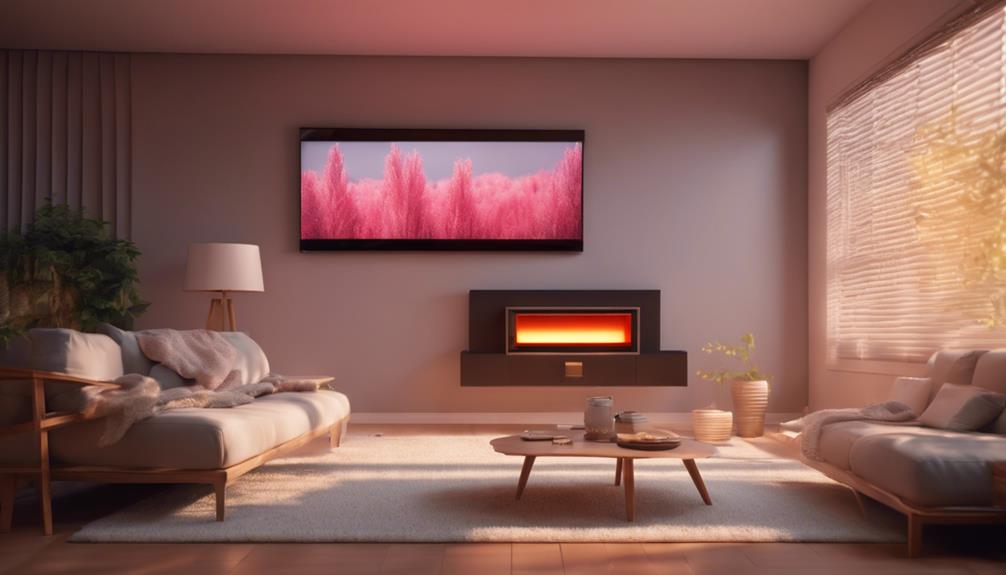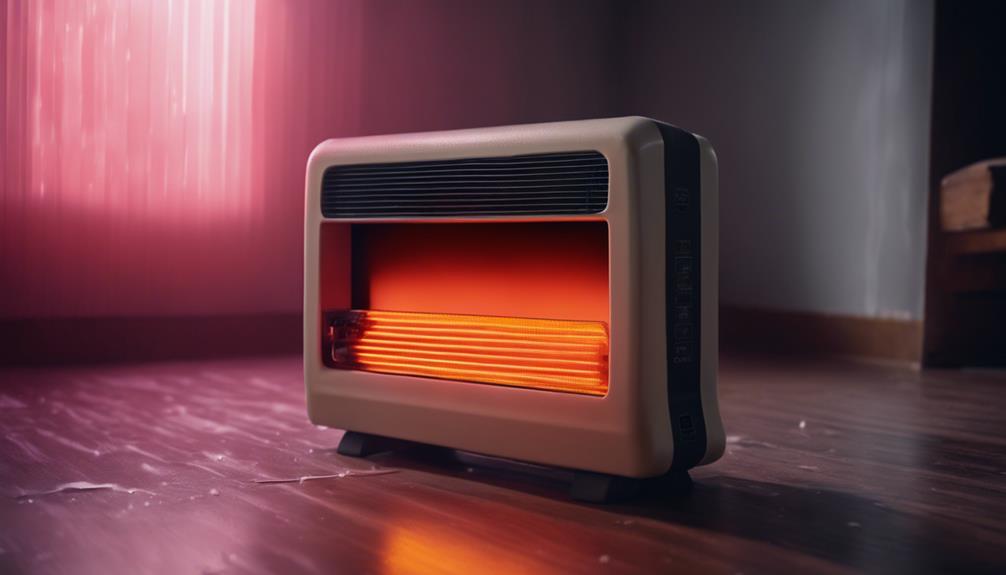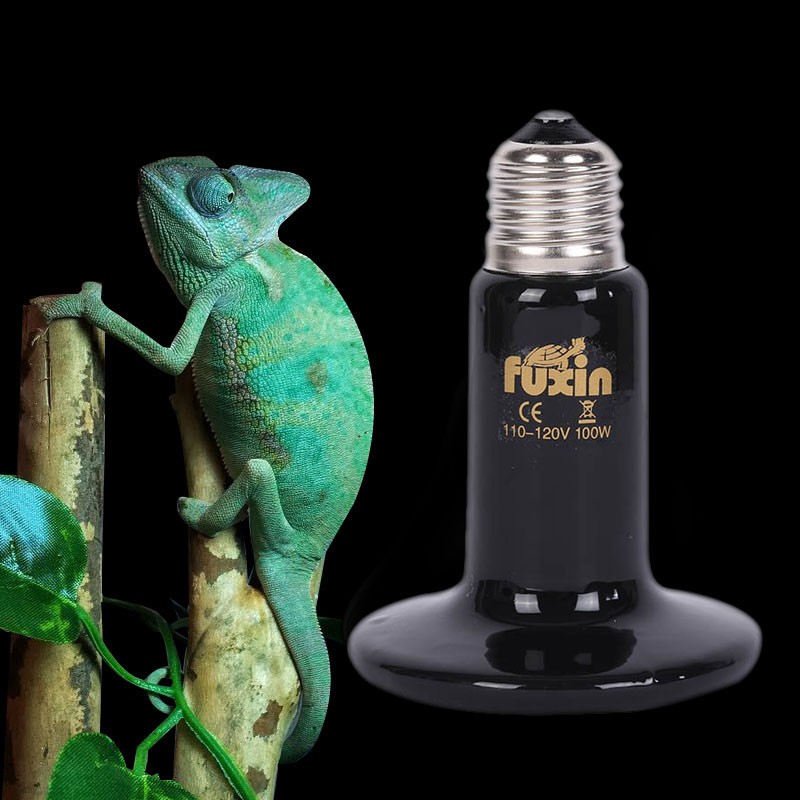
Infrared heaters can greatly benefit those with allergies by reducing airborne irritants like dust, pollen, and pet dander. These heaters emit infrared rays that warm surfaces, creating a comfortable environment while minimizing allergen circulation. By heating objects instead of air, they operate efficiently and lower energy consumption compared to traditional systems. Additionally, infrared heat directly targets allergen-prone areas, disrupting mold and dust mite environments, which can trigger allergy symptoms. The dry and warm conditions created deter allergen growth and offer a natural alternative for allergy relief. Start exploring the extensive health benefits these heaters provide for allergy sufferers.
How Infrared Heaters Help Allergies

Infrared heaters can alleviate allergies by reducing airborne irritants such as dust, pollen, and pet dander in your indoor environment. These heaters emit infrared rays that penetrate the air, warming surfaces and objects without heating the air directly. This process, known as infrared therapy, helps to maintain a comfortable temperature while minimizing the circulation of allergens.
One key benefit of using infrared heaters for allergies is their energy efficiency. Unlike traditional heating systems that warm the air, infrared heaters operate by heating objects and individuals in the room. This targeted heating approach results in lower energy consumption, as there's no need to continually heat and reheat the air to maintain a comfortable temperature.
Reducing Allergens With Infrared Heat
By utilizing the unique heating method of infrared heaters, you can effectively reduce allergens in your indoor environment. Infrared technology works by emitting electromagnetic radiation that directly heats objects and surfaces without heating the air in between. This targeted heating can help in reducing allergens such as dust mites, mold spores, and pet dander that tend to accumulate in carpets, upholstery, and other surfaces.
Infrared heat can disrupt the environment where allergens thrive, as it dries out moisture that mold needs to grow and also reduces the presence of dust mites. Additionally, the gentle warmth from infrared heaters can prevent the circulation of allergens in the air, unlike traditional convection heaters that may stir up particles.
Moreover, infrared heaters don't rely on forced air systems that can spread allergens throughout the room. This can lead to a cleaner indoor environment, promoting better air quality and potentially reducing allergy symptoms for individuals sensitive to common household allergens.
Improving Air Quality for Allergy Relief

Enhancing indoor air quality is essential for providing relief to individuals suffering from allergies. Air purification plays a significant role in reducing allergens present in the air, such as dust mites, pollen, and pet dander, which can trigger allergic reactions. Infrared heaters equipped with air purification systems can help filter out these allergens, creating a cleaner environment that's more conducive to allergy relief.
Moreover, maintaining ideal humidity levels is another key factor in improving air quality for allergy sufferers. Low humidity can lead to dry nasal passages, making individuals more susceptible to allergens, while high humidity can promote mold growth, another common allergen. Infrared heaters that offer humidity control features can help regulate indoor moisture levels, creating a healthier environment for those with allergies.
Alleviating Allergy Symptoms With Infrared
To alleviate allergy symptoms effectively, consider utilizing the advanced technology of infrared heaters designed to combat allergens in your indoor environment.
Infrared therapy, emitted by these heaters, can help reduce allergy symptoms by creating warm environments that discourage the growth of common allergens like dust mites, mold, and pet dander. The infrared heat penetrates deep into surfaces, eliminating moisture that molds and dust mites thrive on, thereby reducing their presence in your home.
By maintaining a warm and dry indoor environment through the use of infrared heaters, you can alleviate allergy symptoms such as sneezing, coughing, congestion, and itchy eyes.
These heaters offer a natural and effective way to combat allergens without the need for harsh chemicals or medications. Additionally, the gentle warmth provided by infrared heaters can soothe irritated airways and help you breathe more comfortably, especially during allergy season.
Preventing Mold Growth With Infrared

Infrared heaters play an essential role in preventing mold growth by effectively eliminating moisture that provides an ideal breeding ground for mold spores.
Mold prevention strategies often revolve around controlling indoor humidity levels, as mold thrives in damp environments. Infrared heaters help in this regard by heating objects directly, which in turn reduces the overall humidity in the room. This process inhibits mold spores from germinating and spreading.
Infrared heaters contribute to mold prevention through their ability to regulate temperature efficiently. By targeting specific areas with infrared heat, these heaters can combat cold spots where moisture tends to accumulate, thereby impeding mold growth.
Additionally, the focused heat distribution helps to dry out damp areas, further deterring mold formation.
Infrared Heaters and Dust Mite Control
In the domain of indoor air quality, infrared heaters play a significant role in controlling dust mite populations through their efficient heating mechanisms. Dust mites thrive in warm and humid environments, making homes an ideal habitat for them. By using infrared heaters to regulate the temperature indoors, you can create an environment that's less favorable for dust mites to survive and reproduce.
These heaters emit infrared radiation that heats objects directly, including furniture, walls, and floors. This heat transfer helps maintain a consistent temperature throughout the room, making it harder for dust mites to find cool spots where they typically thrive. By reducing temperature variations, infrared heaters contribute to dust mite reduction in your living spaces.
Furthermore, the controlled heat provided by infrared heaters can also help decrease humidity levels, another important factor in dust mite proliferation. By keeping the air dry and well-ventilated, you can create an inhospitable environment for these microscopic allergens, ultimately improving indoor air quality and reducing allergy triggers.
Enhancing Allergy Management With Infrared

Utilizing the controlled heat emitted by infrared heaters can greatly aid in managing allergies by creating an inhospitable environment for allergens like dust mites.
Infrared heaters offer a unique approach to allergy prevention strategies by targeting common triggers found in indoor environments. The infrared technology benefits individuals with allergies by reducing the presence of dust mites, mold spores, and pet dander, which are known to exacerbate allergic reactions.
Infrared heaters work by emitting infrared radiation that penetrates objects, warming them directly without heating the air in between. This targeted heat can help control humidity levels, preventing the accumulation of moisture that facilitates the growth of allergens like mold. By maintaining a consistent temperature and reducing moisture, infrared heaters create an environment that's less favorable for dust mites to thrive.
Incorporating infrared heaters into allergy management plans can complement existing strategies, such as regular cleaning, dust mite covers, and air purifiers. By leveraging the benefits of infrared technology, individuals can enhance their efforts to minimize allergen exposure and improve overall indoor air quality.
Conclusion
Overall, the health benefits of using infrared heaters for allergies are clear.
By reducing allergens, improving air quality, alleviating symptoms, preventing mold growth, and controlling dust mites, these heaters provide a valuable tool for enhancing allergy management.
With their ability to target specific areas and provide gentle, efficient heat, infrared heaters offer a practical solution for those looking to alleviate allergy symptoms and create a healthier indoor environment.

